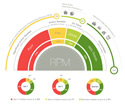The good news is you have a lot of funds to choose from in your 401(k). The bad news is you have a lot of funds to choose from in your 401(k). How to make good choices is the subject of this week’s featured question.
Q. Mr. Moisand, I have a 401(k) plan with my employer. How does one decide how to split the money and where to invest? It is really overwhelming and it seems like there are hundreds of funds to choose from. Knowing I will retire in about 10 years I just added more to the amount that will be taken out of my teacher paycheck. Do you have some suggestions? — M.R.
A. Sure. Keep saving regularly and increase the amount as you can. Basic educational tools should be available to you through your employer that will likely provide information on two big decisions you have to make.
The first decision: Stocks versus bonds. There’s a fundamental trade-off between risk and reward.
The investment selections that are considered most likely to do a good job of staying ahead of inflation over long periods are the funds that invest in stocks. However, stocks have a lousy record of maintaining a steady value and are subject to frequent, sudden, and sometimes huge declines.
Short- to intermediate-term bonds, CDs stable value funds and money-market funds have been steadier in the short term, but haven’t been good at staying ahead of inflation over lengthy periods.
So one of your first tasks will be finding a balance between stability and growth potential that you believe you can stick to even when — and it is a matter of “when,” not “if” — the markets drop substantially.
From there, you decide what types of stocks and bonds you want to own. Then look for the best funds available to you that invest in those types of stocks and bonds. What is “best” is far beyond my space limitations here but when in doubt, defaulting to index funds that track the types of stocks and bonds you want is a good choice.
If your employer’s educational material isn’t doing it for you, you should consider getting some professional assistance. Ask people whose opinions you respect for suggestions and look at the listings of the Financial Planning Association and theNational Association of Personal Financial Advisors for possibilities.
Q. Hi Dan, I enjoy your articles on MarketWatch very much. The nearly universal advice given is to wait at least to Full Retirement Age and ideally to age 70, in order to maximize the Social Security payments, if possible. The advice for those already retired is often to tap into savings for money to live on in order to be able to delay Soc. Sec. and thus obtain the higher payments as well as providing a higher spousal benefit in the event of pre death.
I am 62 and retired now. My wife is 60. I made a spreadsheet. If the money that I did not have to spend was invested, the crossover date was pushed past age 100. To me, claiming early seems like the way to go but this is contrary to the most often given advice. What am I missing?
Another thing to consider is the solvency of Soc.Sec. According to the actuaries, So. Sec. will have depleted the trust fund in 2033. What do you think? Thank you — Drue
A. Drue, you have the basic trade-off correct. If you delay and one of you lives long enough, delaying pays off but you may have to tap your nest egg to fund the delay. It looks to me like you are getting crossover points at much later ages because you not assuming the same spending patterns in both of your spreadsheet scenarios.
To save you some time figuring on your own, I will refer you to Dr. Wade Pfau’s blog in which he calculates the real return on delaying Social Security. (Real return means after-inflation). If you live into your 80s, the real return is far better than what we expect from any other low risk investment. For instance, if one lives to age 84, the implied real return for delaying is 3.2% according to Dr. Pfau. That’s far better than what you can get from U.S. Government TIPS (Treasury inflation-protected securities) and comes without subjecting yourself to market risks. The main risk is longevity. You or your spouse has to live long enough to get the payoff.
Even if benefits are cut by the roughly 25% that is estimated should nothing be done about the Social Security system, the real rate of return still compares favorably to other low risk investment choices. Don’t get me wrong, solvency is a huge issue but it is not likely to go completely unaddressed. Andy Landis had a nice write up about it recently.
Q. Hello Dan. I just turned 62 last week, I have a 6-year-old boy and am a single dad. I am employed full time, in reasonably good health and have other assets. Should I apply for SS benefits now, is there an optimum age for this type of situation? I am well aware that at age 62 the benefit is reduced by some 25%, however the child benefit is 50% of my unreduced benefit. My PIA is $2,130. Thank you so much — Boris, Los Angeles
A. Young children are entitled to benefits once a parent files for retirement benefits, typically until the child reaches 18. Generally, if the child benefits are paid for a long enough period, it more than makes up for the reduction in the parent’s benefit for starting before Full Retirement Age. Don’t forget however, that before FRA, your benefits may be withheld depending on how much you earn from employment. Another thing to consider is suspending benefits at your FRA. The child’s benefit won’t be affected but your retirement benefit will earn delayed credits as long as they are suspended up to age 70.
Q. Hi! Now there are 403-B Roth accounts available at my workplace. Are RMDs (required minimal distributions) applicable to these accounts? Thanks, Dan, NYC
A. Yes, starting at age 70 ½ unless the plan allows you to wait until you retire from your current work. Also, you may be able to transfer your Roth 403(b) to a Roth IRA in your name which isn’t subject to RMDs.
Q. I will be 66 in August (my FRA ) and intend to apply for widower benefits on my deceased wife income. My understanding is that I should file a restricted application as a widower and then file on my own benefits (which are maximum) at age 70. My ex-wife ( divorced in 1997 after 23 years of marriage) is collecting disability but intends to file on my earning record when I reach FRA. Can she do this when I have a restricted application? My understanding is that I should not file and suspend (and then apply for widower benefits) as this won’t result in accrual of benefits (8% year) from age 66 to 70. Is this correct? Thanking you in advance. — R.L.
A. You can restrict your application to only survivor benefits and still earn delayed credits on your record until age 70. Neither you nor your ex needs to coordinate anything with each other. She can get benefits off your record regardless of what you do and vice versa. However, you wouldn’t be able to collect both a survivor benefit off your deceased spouse’s record and a divorce benefit off your ex at the same time. It is one or the other.
Q. My sister’s husband received SSI. He passed away in 2007 from traffic accident. My sister is incarcerated at Pennsylvania state prison. She was there at time of his death. Would she be eligible for any benefits when she is released. They were married for 22 years. Thank you — Sue
A. If she is at least age 60 or 50 and disabled, she should be eligible for a survivor benefit.
Dan Moisand’s comments are for informational purposes only and aren’t a substitute for personalized advice. Consult your adviser about what is best for you.



 Eugenio Marongiu?Shutterstock.com
Eugenio Marongiu?Shutterstock.com

